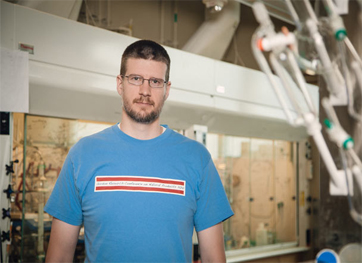
University of Houston assistant professor Jeremy May received a $600,000 National Science Foundation CAREER Award for his chemical reactivity research. He is pictured in front of one of two fume hoods in his lab where he and his team run their experiments. (Photo by Chris Watts)
Jeremy May, an assistant professor of chemistry at UH, received a five-year, $600,000 National Science Foundation (NSF) CAREER Award to develop synthetic strategies to increase the efficiency and yields of chemical reactions. Often requiring a sequence of 30 to 40 different reactions, the process of complex chemical syntheses can be slow, with plenty of waste and not much yield.
“If we can develop chemical transformations that do more in each individual step, then that allows us to use a lot fewer reactions to make the end product,” said May, who specializes in synthetic organic chemistry at UH’s College of Natural Sciences and Mathematics. “I see similarities between my work and other increases in efficiency. In auto manufacturing, for instance, if you can do three welds at once, it’s going to be faster than if you do one weld at a time on a car frame.”
The grant covers the development of a reaction strategy that can form multiple molecular rings within a single transformation. This leads to more complex compounds in less time with greater yield.
“In one reaction, it goes from something that is fairly simple to something that is complex,” he said. “We’re working on compounds with complex interlinked structures, and we’re hoping this reaction strategy will be useful to others studying these types of compounds.”
In this strategy, as the number of reactions decreases, the overall yield increases. According to May, each step has a certain chemical yield, and if they can cut the number of steps or reactions in half, then it more than doubles the yield because it’s like a geometric or exponential progression.
“My main interest is in chemical reactivity – how do chemical bonds form, can we develop new catalysts or new transformations?” he said. “They are tools that can be applied later on, increasing our understanding of how molecules react and how atoms come together to form bonds. While we’re developing these new tools, we may be able to apply them to diseases and solve some problems.”
Specifically, May is targeting complex chemical compounds that can be tested for biological activity. These structures may have a role in disease management, such as efforts to treat cancer and malaria. Researchers, May says, often have insufficient amounts of these compounds for testing. Finding ways to speed up the process of synthesizing complex chemical structures can help scientists increase the availability of compounds of high interest to research. When May’s lab makes compounds, they are shared with colleagues in the Texas Medical Center, where they are kept in a library of chemicals available for screening.
“If they are looking to block the actions that help a cancer cell replicate, they can screen all the chemical compounds in the library to see if one shuts down the mode of action,” May said. “Our work won’t go directly into a clinic or directly tackle a disease, but we will kick off the chain of events.”
In addition to his genuine love of chemistry, May enjoys sharing his enthusiasm with young students. Part of May’s grant includes an educational activity with KIPP Sharpstown College Prep, which is a free, college-preparatory, public school for fifth through eighth grade, serving the Gulfton and Sharpstown neighborhoods of southwest Houston.
“I learned about the school through a friend who teaches history there,” May said. “My goal is to get the students on the UH campus for a day so they can start visualizing what college is like.”
Each June, KIPP Sharptown’s seventh and eighth grade students will tour May’s lab and learn about the work done there and the process of doing scientific research. UH undergraduate and graduate students working in May’s lab will talk about preparing to get into college, the college experience and opportunities after college.
“The KIPP students get a pair of safety glasses, so they can tour the lab safely, and they take them home as a reminder of their visit,” May said. “KIPP is a wonderful institution with the goal of ensuring their students become lifelong learners capable of excelling in college.”
Given to talented junior faculty members who best exemplify the role of teacher-scholar, NSF CAREER Awards are quite competitive and require recipients to demonstrate outstanding research and excellence in education, as well as the integration of the two.
###
About the University of Houston
The University of Houston is a Carnegie-designated Tier One public research university recognized by The Princeton Review as one of the nation’s best colleges for undergraduate education. UH serves the globally competitive Houston and Gulf Coast Region by providing world-class faculty, experiential learning and strategic industry partnerships. Located in the nation’s fourth-largest city, UH serves more than 39,500 students in the most ethnically and culturally diverse region in the country. For more information about UH, visit the university’s newsroom.
About the College of Natural Sciences and Mathematics
The UH College of Natural Sciences and Mathematics, with 193 ranked faculty and nearly 6,000 students, offers bachelor’s, master’s and doctoral degrees in the natural sciences, computational sciences and mathematics. Faculty members in the departments of biology and biochemistry, chemistry, computer science, earth and atmospheric sciences, mathematics and physics conduct internationally recognized research in collaboration with industry, Texas Medical Center institutions, NASA and others worldwide.
To receive UH science news via email, sign up for UH-SciNews.
For additional news alerts about UH, follow us on Facebook and Twitter.